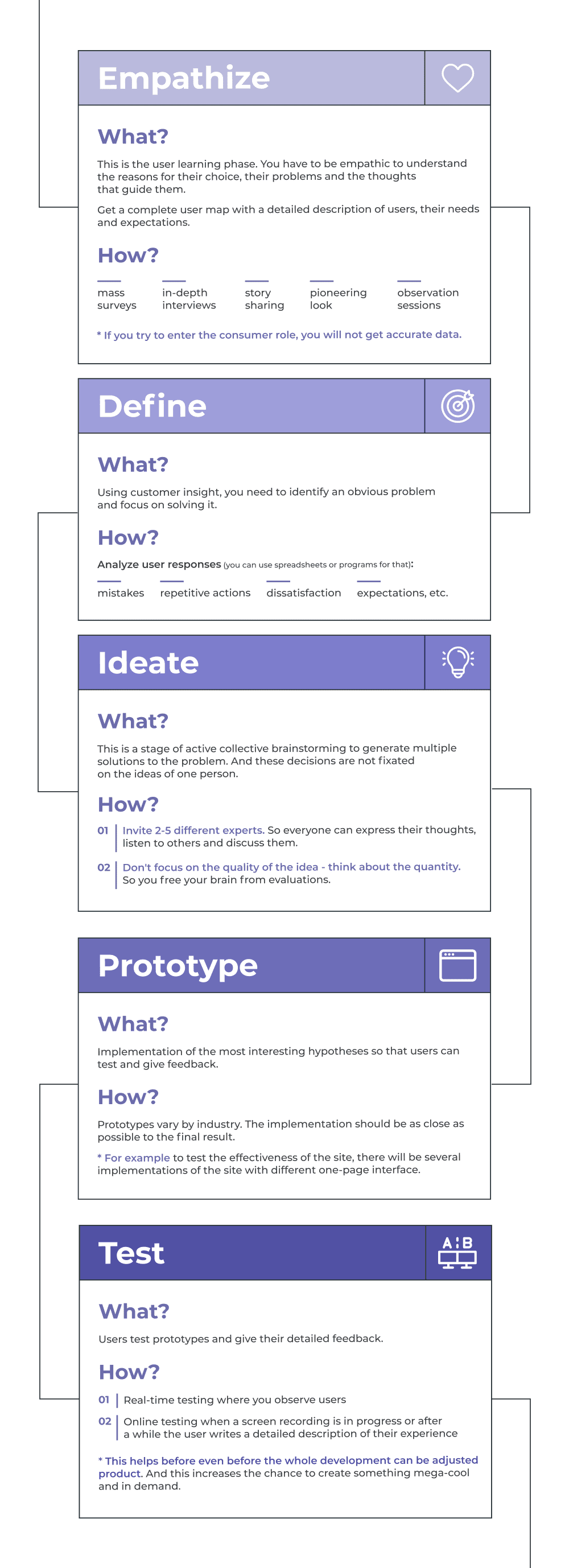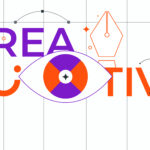Design Thinking Principles: The Cornerstones of Problem-Solving
Have you ever encountered a problem for which there seems to be no solution? Then the design thinking principles can help you.
By the name, you might think that it is associated only with the design field. But this is not so, and today we will try to figure it out.
In the article, you can find answers to your questions, what it is, how to use it and for whom it suits. After reading it, you can try to apply the design thinking steps in your work and see the result.
Moreover, if you want to delve into this topic, you will find a selection of books and free courses in this article. I will be very grateful for the feedback on this article – leave a comment or share it with your buddies.
What Is Design Thinking?
Design thinking is a human-centered way of finding out-of-the-box solutions. It can be used both in personal life and to create innovative products or solve complex problems in business, the state, and the world order.
Let’s quickly go over the main development points of this method. This will help to better understand based on what it arose and how it evolved to its modern form.
A Brief History of Design Thinking
Design thinking originated in the 20th century. Engineer and designer Buckminster Fuller decided to test the influence of science on the result of design activity. Therefore, for the effectiveness of design, he attached chemists, engineers, technicians, etc. to the tasks.
This interdisciplinary approach helped revolutionize the world of engineering. This approach of combining scientific and creative formed the basis for developing design thinking.
And it was already impossible to stop this process.
In 1969, Simon, Nobel Laureate in Economics, published The Science of the Artificial. In it, he proposed the first doctrines of design thinking phases:
- rapid prototyping
- testing through observation of users of this product.
In parallel, the corporate design was developing in Scandinavia. Designers organized brainstorms with potential users and captured the main exciting ideas.
Later, design theorist David Norman improved on this method and proposed a new formula where the design should be user-centric. That also became part of the principles of design thinking.
In 1980, the book “How Designers Think” by psychologist and designer Brian Lawson was published. It was based on his experiment with scientists and architects.
Task: to understand what distinguishes creative people from others.
Implementation: Invited future scientists and architects, who were divided into 2 groups. Gave me an assignment. It is necessary to build a one-story structure of colored blocks so that the perimeter has red and blue colors. The rest of the parts could be painted randomly.
Result: Scientists did not have enough time to build because. most of it was spent on research. They thought through each of the possible combinations, then formulated a hypothesis about the fundamental pattern that they must follow to arrange the blocks according to the condition. That is, scientists were focused on the problem.
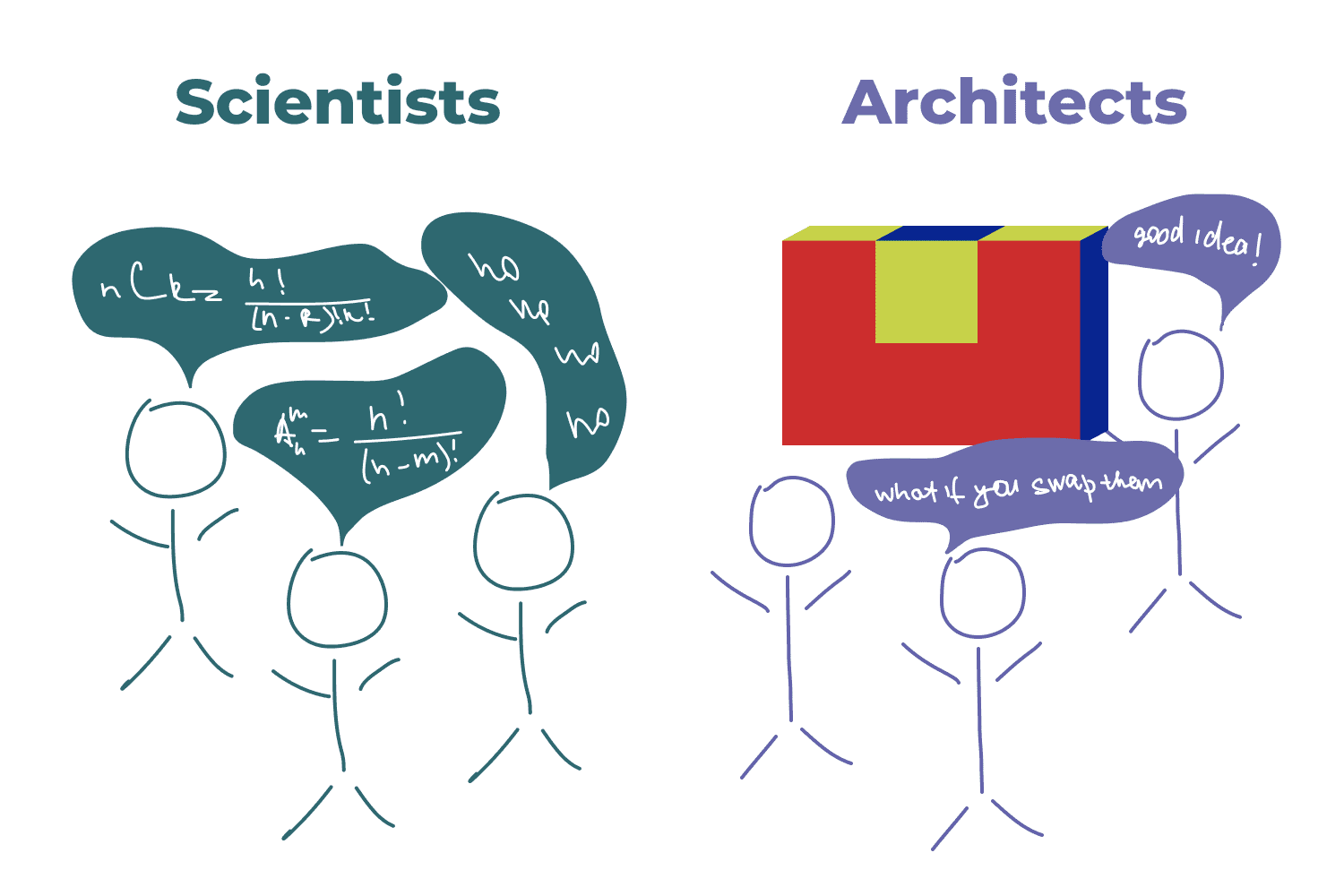
The designers went the other way. They built structures on rapidly accepted ideas and tested whether these structures met the given condition. That is, they were focused on finding a solution.
One of the defining moments in the development was the creation of IDEO by David Kelly. This is a consulting company that actively uses the principles of design thinking to solve complex problems.
They created the first mouse for Apple, worked on sanitation issues in Ghana, and now help many large companies unconventionally solve their problems.
In essence, the founders of IDEO put together a process methodology, summarizing all previous theoretical developments, and proposed a basic terminology for design thinking.
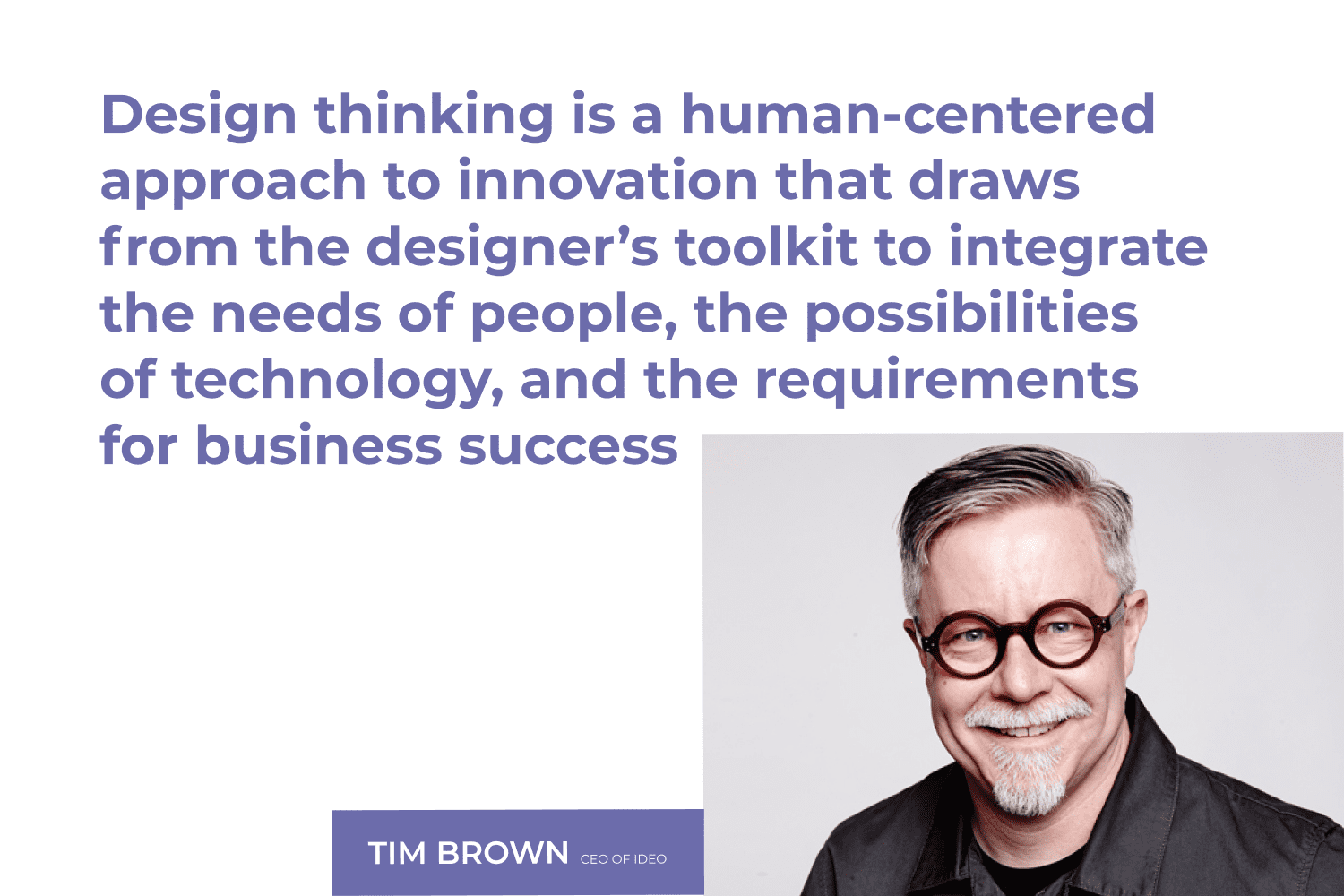
Of course, there were more stages of development, but then we would not have gone further. And we go, and the next thing we learn more about principles of design thinking.
Design Thinking = Creative Thinking?
You may have a question is design thinking = creative thinking? Not certainly in that way. The main difference is that design thinking is a clear methodology that is understandable and adaptable to different task scales. This system can be learned in various design thinking trainings.
Creative thinking does not have a clear definition, much less a methodology of application. It is simply an unconscious departure of a particular person from the accepted problem-solving schemes. But it doesn’t scale, hasn’t a system, and can’t be taught. Creativity is subjective and tied more to the worldview of a particular person.
The Main Principles of Design Thinking
Decisions should be based on four certain pillars of Design Thinking:
- Human orientation. Users should be at the center of the product. You need to understand the true pains, problems, and causes of people’s behavior patterns to create a truly working solution.
- Finding different ways to solve a problem. Don’t get hung up on one idea, even if it seems brilliant. Collect as many hypotheses, ideas, and suggestions as possible to solve the problem. After all, sometimes you can hit the jackpot on an idea that you would never bet on. This also works in reverse.
- The tangibility of the solution. Create prototypes so ideas can be tested. So you can quickly understand what is effective and what does not work at all. One way you could do that is by using creative approval software to analyze the mockup and collect feedback on the solution from the stakeholders.
- Redesign. If you look globally, all that is being done is a redesign. The world is changing rapidly, basic human needs remain more stable. It turns out that we are redesigning the means of satisfying these needs.
IDEO interestingly conveyed an understanding of the conditions under which design thinking and its principles can work. Innovative solutions and success are at the intersection of three pillars.

How to Apply Design Thinking to Problem-Solving?
The Interaction Design Foundation has brought together the principles of design thinking and combined them into a methodology. There are five understandable phases, each of which has its design thinking exercises.
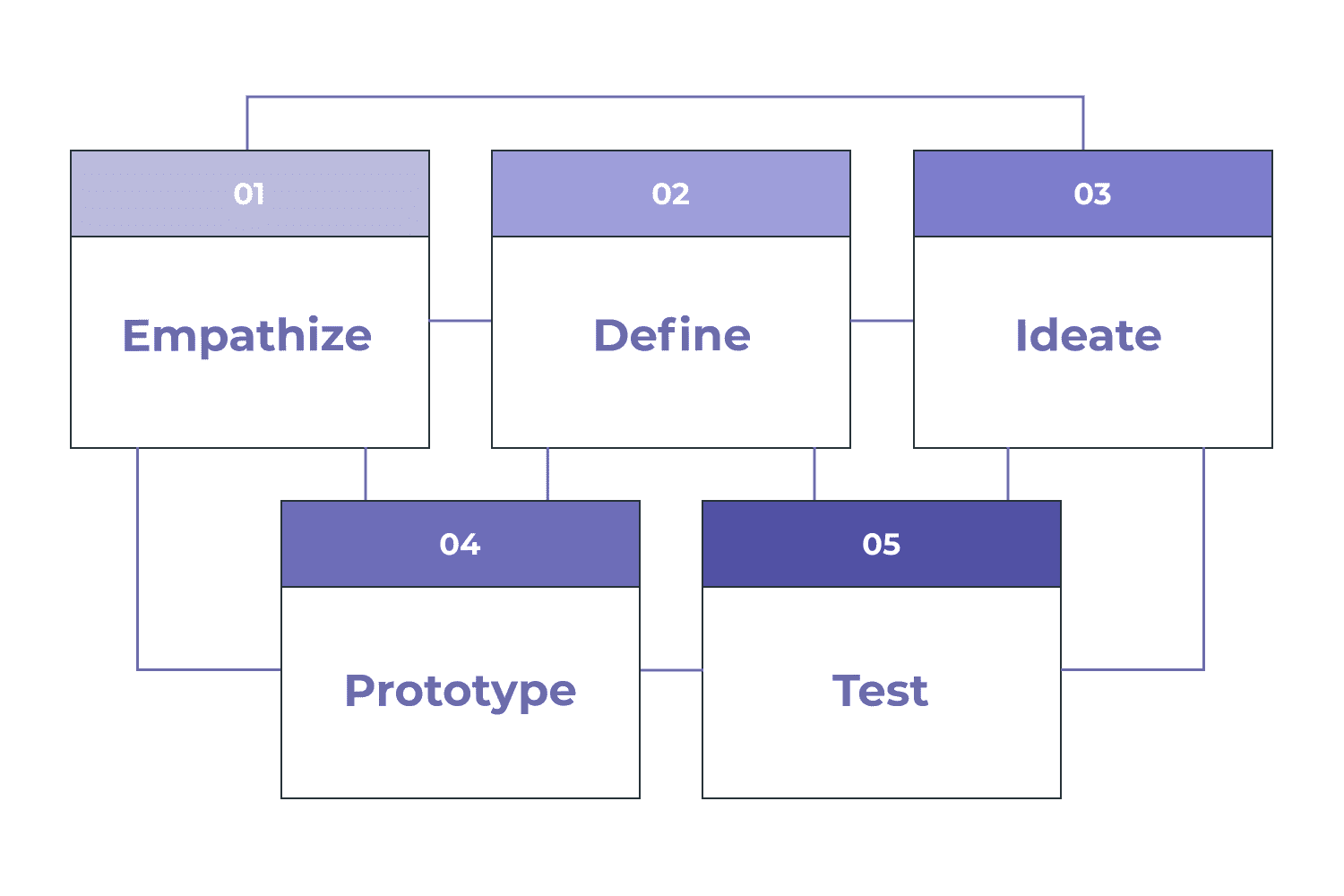
At the same time, the beauty of the method lies in its flexibility. The presence of stages does not mean that you need to move strictly along them. On the contrary, actions in one stage reveal new information, and you can return to the previous stage. The methodology is transparent, but you have the freedom to move along it.
Let’s take a look at each phase in more detail.
Remember that this system is non-linear and after each stage, there may be a rollback to the previous one to improve it. Do not try to do everything quickly, this approach takes time, and this must be taken into account.
I propose to analyze one of the situations using these design thinking exercises.
Examples Of Design Thinking
Before we break down usage design thinking principles, let’s see why it’s chosen:
- the opportunity to receive many potential solutions at the same time and consider them from all possible sides, choose the best ones
- the ability to study the end user in-depth and look for user-centric solutions
- the versatility of people working together to solve a problem helps to look at it from different angles
- effective in conditions of uncertainty, when the task is fuzzy or unknown
- understandable stages of design thinking that logically follow each other. You can repeat one step or the entire procedure as often as needed.
Let’s see extraordinary cases.
MRI scanner for children
There was a problem that children did not tolerate tomography well. Almost 80% of the children were given sedatives before the procedure, which also caused a negative experience.
Doug Dietz, who was developing CT scanners, decided he needed to change his approach. But it was not the device itself. The problem was the fear of children; it was with him that we had to work.
He began to analyze children’s behavior in kindergarten and to communicate with child psychologists. Together with the team, he came up with the idea of turning the procedure into a game. So the scary tomograph became a pirate ship, the office became the sea, and the child participated in an exciting journey. The hospital workers adhered to the developed scenario and sent the children on a voyage.
Satisfaction with the procedure rose to 90%. So there were offices with other scenarios. Children tolerated the procedure more calmly, which reduced repeated sessions. This also had a positive financial effect due to savings on the maintenance of additional staff and other costs.
Youth insurance
MassMutual’s insurance company faced the problem that the younger generation was indifferent to life insurance. They turned to IDEO, which uses design thinking principles in its work.
Over two years, they conducted extensive research on users, the causes of behavior, and motives. Based on what they learned, they embarked on another two years of prototyping and testing the platform.
As a result, the Society of Grownups platform was created, which helps teach young people how to manage finances.
Airbnb
In 2009, Airbnb was close to bankruptcy as the three founders earned $200 a week. The startup launched, and the idea was exciting and seemingly convenient for people, but there was no demand.
So they began to analyze what hinders the success of the business. After several hours of viewing the exhibited housing, Gabbea noticed a pattern – all the photos were of poor quality. And really, how can you pay rent if you don’t even know what you’re getting?
Paul Graham devised a complex but ingenious idea to solve the problem. So, they took the next tickets to New York and flew there to take professional photos of the objects.
A week after such a non-scalable and non-standard decision, Airbnb’s revenue grew to $400 per week. This has become a growth point for a loss-making startup to become a market leader.
Thanks to this non-standard solution, Airbnb has become one of the brightest examples of design thinking.
Best Books About Design Thinking at 2023
If you liked the topic of design thinking and want to learn more, then keep this selection of books for yourself:
| Product Image & Rating (Out Of 10) | Product Name | Price |
|---|---|---|
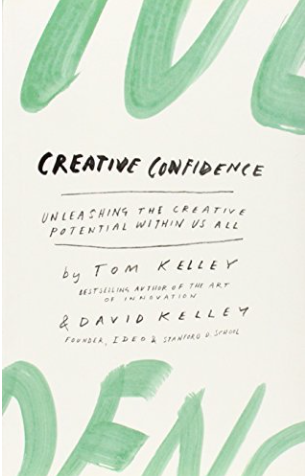 9.9
|
Creative Confidence: Unleashing the Creative Potential Within Us All by David M. Kelley and Tom Kelley
|
Check Price |
 9.7
|
Change by Design: How Design Thinking Transforms Organizations and Inspires Innovation by Tim Brown
|
Check Price |
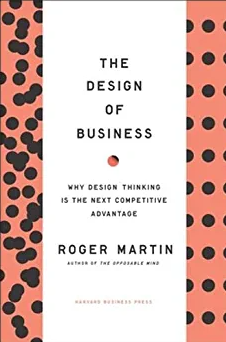 9.8
|
The Design of Business: Why Design Thinking is the Next Competitive Advantage by Roger L. Martin
|
Check Price |
 9.5
|
Designing Experiences by J. Robert Rossman and Mathew D. Duerden
|
Check Price |
 9.9
|
100 Things Every Designer Needs to Know About People by Susan M. Weinschenk
|
Check Price |
 9.9
|
The Field Guide to Human-Centered Design by IDEO
|
Check Price |
Free Design Thinking Education
If you have a couple of free evenings or want to improve your skills, then you can take the time to take these small free courses in design thinking.
- Enterprise design thinking
- Design Thinking: Transforming Teams by Stanford Online
- Stanford Webinar – Design Thinking = Method, Not Magic, Bill Burnett by Stanford Online
- Human-Centered Design for Inclusive Innovation by the University of Toronto
- Design Thinking for Beginners
- Introduction to Design Thinking
All right, you can exhale, we’ll end here. I understand that there is a lot of information, but on the other hand, you learned what design thinking principles are, where it is applied, what the stages are, and how to adapt them to your tasks. Save this article for yourself so that you can return to a selection of books and courses at any time.
I would be very grateful if you put feedback in the form of a like on the article and share it with your friends.
Some Awesome Videos About Design Thinking
What Is Design Thinking? An Overview
What is Design Thinking? Why is it still so important? In this video AJ&Smart CEO Jonathan Courtney shares the definition of Design Thinking, an overview of the processes, and why they’re so important to innovation!
FAQ
Here are some frequently asked questions about design thinking:
What are the 5 Design Thinking Principles?
To solve a problem using the design thinking principles, you need to use the following steps:
- empathize
- define
- ideate
- prototype
- test
These stages are non-linear and you can periodically go through some anew for as long as you need for a working result.
What are the 4 Pillars of Design Thinking?
Design thinking methodology decisions are based on four main Pillars:
- Your decisions must be human-centered
- You need to generate as many ideas as possible from different angles
- The whole design is essentially a redesign, only the true needs of people are unchanged
- You must create tangible prototypes of suitable solutions and test them on real users.
What are the 5 Or 6 Stages of Design Thinking?
5 main phases of design thinking are often used, but a final one can be added. Then the solution to the problem this method will go through the following steps:
- Empathize- identification of behavioral characteristics, pains, desires, and personalities of users
- Focus – analysis of user responses and identification of common patterns, and therefore the main problems that need to be solved
- Idea generation – collective brainstorming to get a lot of ideas from people with different opinions
- Prototype- implementation of basic ideas for testing
- Test – testing prototypes by real users to select the most effective solution or new problems to improve
- Implement – complete and high-quality implementation of the intended product or service
What are your concerns?
Thanks for your response!
Disclosure: MasterBundles website page may contain advertising materials that may lead to us receiving a commission fee if you purchase a product. However, this does not affect our opinion of the product in any way and we do not receive any bonuses for positive or negative ratings.

